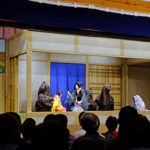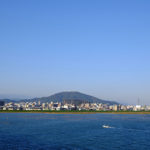Awa Odori (Awa Dance)

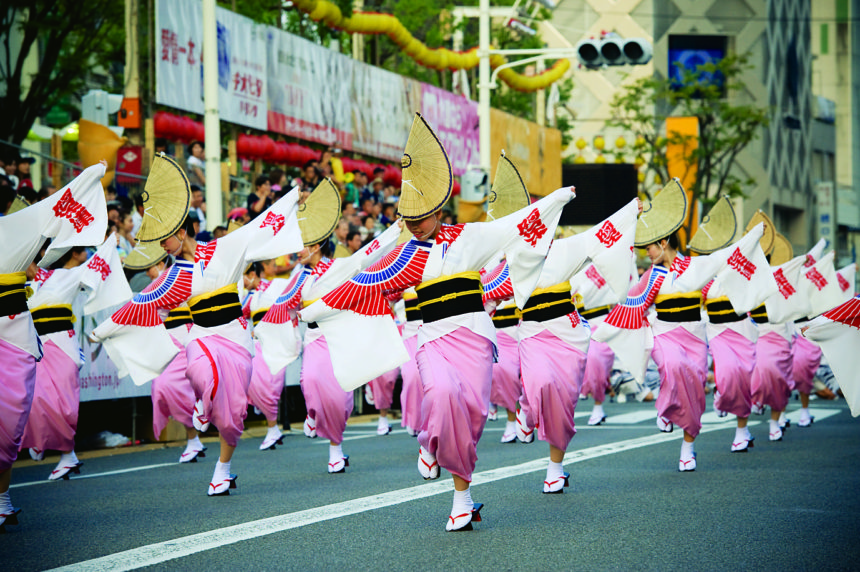 The city of Tokushima attracts more than a million visitors from August 12 to 15 for its annual Awa Odori, one of the largest festivals in Japan. Awa is the former name for Tokushima Prefecture and Odori means “dance.” The term Awa Odori can refer both to the festival and the dancing itself.
The festival’s roots date back more than 400 years, but the name “Awa Odori” was coined when Tokushima started promoting the event to attract tourists during the prewar Showa era (1926–1945). Dance events take place in various locations throughout the prefecture every summer but the city of Tokushima is the main base.
During the festival, the city takes on a carnival-like atmosphere. Troupes of dancers called renparade through the streets, accompanied by musicians playing traditional instruments. The spirit of Awa Odori is perhaps best captured in these words from the popular festival song Awa Yoshikono: “Dancing fools and watching fools! Everyone’s a fool, so why not dance?”
Teamwork at Its Finest
While the basic steps of Awa Odori are the same for men and women, they are executed in two distinct styles. The men adopt a low posture with their knees and feet pointing outward when they dance. The women usually perform in tight formation, balancing on the front of their wooden getasandals with their hands held high in the air. Men usually wear happi, a short festival coat, while women dress in colorful kimono and amigasa,a braided straw hat with a distinctive half-moon shape.
Children have been participating in Awa Odori since the 1970s, performing at the festival alongside adults. In recent years, some women have taken up the traditional men’s style and costume. Sometroupes feature a dynamic freestyle form known as yakko-odori (kite dancing), in which a single male dancer performs acrobatics.
Musicians play an important role in Awa Odori. An ensemble of traditional Japanese instruments, collectively called narimono, provides lively music in double-time for the dancing. Narimonomay include bass and rhythm drums, a flute, a shamisen, and a handheld gong that sets the tempo.
Around 800 renof varying skill levels perform at the Awa Odori each year. These teams may represent family members, colleagues, or groups of university students. They parade through the streets with one or more members in the lead carrying a bamboo pole with takahari chochin(paper lanterns), which bear the troupe’s name. While professional troupes practice year-round, Awa Odori is a folk dance and open to all. There is even an allocated time when the niwaka-ren(drop-in team) appears and everyone is invited to join in the dancing.
Origins of Awa Odori
Some researchers suggest that Awa Odori has roots in the nationwide tradition of Bon Odori dancing, which is performed across the country each summer. One story about its origin connects it to celebrations surrounding the completion of Tokushima Castle in 1586. The first lord of Tokushima, Hachisuka Iemasa (1558–1638), is said to have distributed free sake to residents, encouraging them to dance. The custom must have caught on, as later records show that in 1671, the following rules were issued to control the festivities:
The city of Tokushima attracts more than a million visitors from August 12 to 15 for its annual Awa Odori, one of the largest festivals in Japan. Awa is the former name for Tokushima Prefecture and Odori means “dance.” The term Awa Odori can refer both to the festival and the dancing itself.
The festival’s roots date back more than 400 years, but the name “Awa Odori” was coined when Tokushima started promoting the event to attract tourists during the prewar Showa era (1926–1945). Dance events take place in various locations throughout the prefecture every summer but the city of Tokushima is the main base.
During the festival, the city takes on a carnival-like atmosphere. Troupes of dancers called renparade through the streets, accompanied by musicians playing traditional instruments. The spirit of Awa Odori is perhaps best captured in these words from the popular festival song Awa Yoshikono: “Dancing fools and watching fools! Everyone’s a fool, so why not dance?”
Teamwork at Its Finest
While the basic steps of Awa Odori are the same for men and women, they are executed in two distinct styles. The men adopt a low posture with their knees and feet pointing outward when they dance. The women usually perform in tight formation, balancing on the front of their wooden getasandals with their hands held high in the air. Men usually wear happi, a short festival coat, while women dress in colorful kimono and amigasa,a braided straw hat with a distinctive half-moon shape.
Children have been participating in Awa Odori since the 1970s, performing at the festival alongside adults. In recent years, some women have taken up the traditional men’s style and costume. Sometroupes feature a dynamic freestyle form known as yakko-odori (kite dancing), in which a single male dancer performs acrobatics.
Musicians play an important role in Awa Odori. An ensemble of traditional Japanese instruments, collectively called narimono, provides lively music in double-time for the dancing. Narimonomay include bass and rhythm drums, a flute, a shamisen, and a handheld gong that sets the tempo.
Around 800 renof varying skill levels perform at the Awa Odori each year. These teams may represent family members, colleagues, or groups of university students. They parade through the streets with one or more members in the lead carrying a bamboo pole with takahari chochin(paper lanterns), which bear the troupe’s name. While professional troupes practice year-round, Awa Odori is a folk dance and open to all. There is even an allocated time when the niwaka-ren(drop-in team) appears and everyone is invited to join in the dancing.
Origins of Awa Odori
Some researchers suggest that Awa Odori has roots in the nationwide tradition of Bon Odori dancing, which is performed across the country each summer. One story about its origin connects it to celebrations surrounding the completion of Tokushima Castle in 1586. The first lord of Tokushima, Hachisuka Iemasa (1558–1638), is said to have distributed free sake to residents, encouraging them to dance. The custom must have caught on, as later records show that in 1671, the following rules were issued to control the festivities:
- Dancing to last three days only.
- Samurai not allowed to participate.
- Strictly no dancing on temple grounds.
<簡体字> 阿波舞 “阿波舞祭”是日本最大的节庆之一,每年8月12日至15日在德岛市举行的“阿波舞祭”最有名,规模也最大,每年吸引约130万游客,参与表演的舞者约有10万之众。阿波舞的日文写作“阿波おどり”,“阿波”是德岛县的旧称,“おどり”即“舞蹈”。“阿波おどり”一词既可以指阿波舞祭这个节日,也可以指阿波舞本身。 阿波舞已有400多年历史,但这个名字直到战前的昭和时代(1926-1945)才问世。每年夏天,德岛县各地都会举办舞蹈活动,但最热闹的始终是德岛市。 阿波舞祭期间,整个德岛市中心化身舞蹈的海洋,沉浸在嘉年华般的热闹气氛中。舞蹈表演者以“连”(方阵)为单位,沿着街道边行进边舞蹈,演奏传统乐器的乐师们紧随其后。流行的节日歌曲《阿波よしこの》的歌词道出了阿波舞的精神:“踊る阿呆に見る阿呆同じ阿呆なら踊らにゃ損々”——“跳的也傻,看的也傻,既然都傻,不跳最傻。”
最佳团队合作 虽然阿波舞的男女舞步基本相同,但表现方式却截然不同。男人们身着“法被”(一种在祭祀节日中穿的短褂),放低身体,膝盖和双脚朝外走舞步。女人则通常排列成紧密的方阵,穿着色彩缤纷的浴衣(夏季穿的一种轻便和服),头戴高高的半月形草编斗笠,踩着高跟木屐,双手高举,用脚尖保持平衡。 从20世纪70年代开始,小孩子也加入了阿波舞的行列。近年来,一些女性也会穿着男性传统服装跳男人的舞步。某些舞团会跳一种形式自由而活泼的“奴踊り”(Yakko-odori),其中有一名男子负责表演杂技。 乐师在阿波舞中至关重要。他们演奏时用的传统乐器统称为“鳴り物”(Narimono),通常由大太鼓(控制低音的大鼓)、缔太鼓(控制节奏的中鼓)、横笛、三味线(日本传统弦乐器,类似三弦)和控制节奏的钲(金属鼓面的打击乐器)组成。乐师合着舞步,奏响双拍子节奏的欢快音乐。 每年大约有800个不同水平的“连”参与阿波舞表演,他们可能是家庭、同事或是大学生团体。舞团在街道上行进时,由一名或多名成员领头,他们举着竹竿,上面挂着印有舞团名字的高悬提灯(纸灯笼)。专业舞团全年都在练习,但阿波舞依然属于民间活动,人人皆可参与。阿波舞祭上甚至特别拨出时间,供观众即兴参与“にわか连”(Niwaka-ren,即兴连),只要身着方便运动的服装,每个人都可以自由参与。如想追求更投入的气氛,也可向主办方租赁印有“にわか连”字样的法被。
阿波舞的由来 有研究人员认为,阿波舞起源于每年夏天在日本全国举行的传统盆舞。而另一种起源说则认为,阿波舞与1586年德岛城建成时的庆典活动相关。据传,当时德岛的第一任藩主蜂须贺家政(1558-1638)向城民免费派发清酒,鼓励人们歌舞欢庆。有记载表明,这种跳舞的习俗在当时已经流行,当地甚至在1671年颁布过控制管理庆祝活动的规范,具体条款包括: 1. 跳舞只能持续三天。 2. 武士不可参加舞蹈。 3. 严禁在寺庙内跳舞。
现代阿波舞 江户时代(1603-1868)在德岛蓬勃发展的蓝染产业支撑着庆典活动,在19世纪的艺术作品中就能发现成群结队的快乐舞者,领略到阿波舞表演的热闹精彩。然而,随着更便宜的合成染料从海外而来,蓼蓝(含靛蓝较多的一种植物)种植在20世纪早期开始减少。德岛转而求诸于旅游业,为提高人们对舞蹈活动的兴趣,“阿波舞”这个名字由此诞生。 1931年,艺伎兼歌手多田小馀绫(1907-2008)通过她的热门歌曲《阿波よしこの》帮助推广了阿波舞。二战前夕及期间,德岛都没有举行过节庆活动,但在1946年就恢复了阿波舞祭。1970年,大阪世博会首次让世界观众认识了这种舞蹈,从那以后,一些团体甚至远赴国外演出。 大阪世博会也是推进阿波舞改良的催化剂。世博会上的表演者们积极地吸引观众一起参加,让他们充分感受舞蹈的乐趣。于是在随后几年,一种更为精致的阿波舞发展起来,逐渐演化为今天的模样。 来访者全年都可以在德岛的阿波舞会馆观看表演。当地“连”和各种嘉宾团队每天轮流上演四五场阿波舞。观众可以在每次表演的最后加入舞蹈,了解相关服饰和乐器。参观结束后,还可以从5楼乘坐索道直达德岛市地标眉山的山顶。
<繁体字> 阿波舞 「阿波舞祭」是日本最大的節慶之一,每年8月12日至15日在德島市舉行的「阿波舞祭」最有名規模也最大,每年可吸引約130萬遊客,參與表演的舞者約有10萬人之多。阿波舞的日文寫作「阿波おどり」,「阿波」是德島縣的舊稱,「おどり」即「舞蹈」。「阿波おどり」一詞既可以指阿波舞祭這個節日,也可以指阿波舞本身。 阿波舞已有400多年歷史,但這個名字直到戰前的昭和時代(1926-1945)才問世。每年夏天德島縣各地都會舉辦舞蹈活動,但最熱鬧的始終是德島市。 阿波舞祭期間,整個德島市中心化身舞蹈的海洋,沉浸在嘉年華般的熱鬧氣氛中。舞蹈表演以「連」(方陣)為單位,沿著街道邊行進邊舞蹈,演奏傳統樂器的樂師們緊隨其後。流行的祭典歌曲《阿波よしこの》的歌詞道出了阿波舞的精神:「踊る阿呆に見る阿呆同じ阿呆なら踊らにゃ損々」——「跳的也傻,看的也傻,既然都傻,不跳最傻。」
最佳團隊合作 雖然阿波舞的男女舞步基本相同,但表現方式卻截然不同。男人們身著「法被」(一種在祭祀節日中穿的短褂),放低身體、膝蓋和雙腳朝外走舞步。女人則通常排列成緊密的方陣,穿著色彩繽紛的浴衣(夏日裡穿的一種輕便和服),頭戴高高的半月形草編斗笠,踩著高跟木屐,雙手高舉,用腳尖保持平衡。 從1970年代開始,小孩子也加入了阿波舞的行列。近年來,一些女性也會穿著男性傳統服裝跳男人的舞步。某些舞團會跳一種形式自由而活潑的「奴踊り」(Yakko-odori),其中有一名男子負責表演雜技。 樂師在阿波舞中有著重要的作用,演奏時用的傳統樂器統稱為「鳴り物」(Narimono),通常由大太鼓(控制低音的大鼓)、締太鼓(控制節奏的中鼓)、橫笛、三味線(日本傳統弦樂器)和控制節奏的鉦(金属鼓面的打擊樂器)組成。樂師合著舞步奏響雙拍子節奏的歡快音樂。 每年大約有800個不同舞蹈程度的「連」參與阿波舞表演,他們可能是家庭、同事或是大學生團體。舞團在街道上行進時,由一名或多名成員領頭,他們舉著竹竿上面掛著印有舞團名字的高懸提燈(紙燈籠)。專業舞團全年都在練習,但阿波舞依然屬於民間活動,人人皆可參與。阿波舞祭上甚至特別撥出時間,供觀眾即興參與「にわか連」(Niwaka-ren,即興連),只要身著方便運動的服裝,每個人都可以自由參與。如想追求更投入的氣氛,也可向主辦方租賃印有「にわか連」字樣的法被。
阿波舞的由來 有研究人員認為阿波舞起源於每年夏天在日本全國舉行的傳統盆舞。而另一種起源說則認為,阿波舞與1586年德島城建成時的慶典活動相關。據傳當時德島的第一任藩主蜂須賀家政(1558-1638)向城民免費送酒,鼓勵人們歌舞歡慶。有文獻記載這種盆舞習俗在當時非常流行,當地甚至在1671年頒佈過祭典的相關規範,具體條款包括: 1. 跳舞只能持續三天。 2. 武士不可參加舞蹈。 3. 嚴禁在寺廟內跳舞。
現代阿波舞 江戶時代(1603-1868)在德島蓬勃發展的藍染產業支撐著慶典活動,在19世紀的藝術作品中就能發現成群結隊的快樂舞者,領略到阿波舞表演的熱鬧精彩。然而,隨著更便宜的合成染料從海外而來,蓼藍(含靛藍較多的一種植物)栽種在20世紀早期開始減少。德島轉而發展旅遊業來提高人們對舞蹈活動的興趣,「阿波舞」這個名字由此誕生。 1931年,藝妓兼歌手多田小餘綾(1907-2008)透過她的熱門歌曲《阿波よしこの》來推廣阿波舞。二戰前夕及期間德島都沒有舉行過節慶活動,但在1946年就恢復了阿波舞祭。1970年,大阪世博會首次讓世界觀眾欣賞到了這種舞蹈,從那以後,一些劇團甚至遠赴國外演出。 大阪世博會也是推進阿波舞改良的催化劑,世博會上的表演者們想積極地吸引觀眾一同參加,讓他們充分感受阿波舞的樂趣。於是在隨後幾年,一種更為精緻的阿波舞發展起來,逐漸演化為今天的模樣。 遊客全年都可以在德島的阿波舞會館觀看表演,當地「連」和各種嘉賓團隊每天輪流上演四五場阿波舞,觀眾可以在每場表演的最後加入舞蹈,瞭解相關服飾和樂器。參觀結束後,還可以從5樓乘坐纜車直達德島市地標眉山的山頂。
Awa Jurobe Yashiki Puppet Theater and Museum
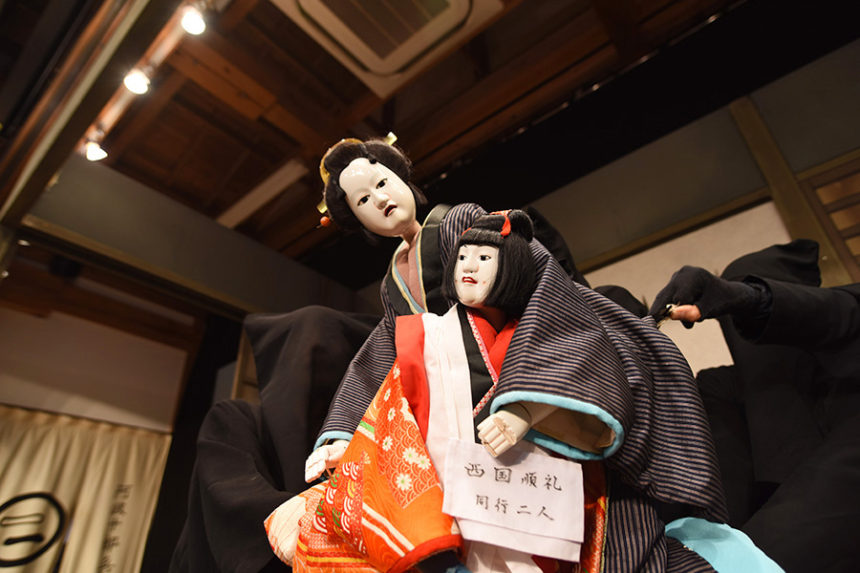 This theater and museum complex offers visitors a chance to experience and learn about the unique puppet theater of Tokushima: Awa Ningyo Joruri. A combination of storytelling, music, and puppetry, the art form is a designated Important Cultural Property. Awa is the former name of Tokushima Prefecture, and Ningyo Joruri means puppet theater.
Local puppeteer troupes perform once or twice daily at the Awa Jurobe Yashiki Puppet Theater. Visitors can learn more about the puppets, the costumes, and the history of this performing art in the adjoining exhibition room, where they can even try their hand at operating the puppets. The complex stands on the former estate of a village headman named Bando Jurobe (1646–1698), and includes his traditional garden.
Roots in Farming Communities
Tokushima’s puppetry shares roots with Japan’s mainstream puppet theater, Bunraku. However, as Awa Ningyo Joruri was often performed on outdoor stages, its puppets tend to be larger so that they may be viewed more easily from a distance. Depending on the age and gender of the character, the puppets can be half to two-thirds life-size. Tokushimapuppets usually have a glossy painted finish, unlike the matte surface of those used in Bunraku.
Awa Ningyo Joruri came to the region from Awaji Island, to the north of Tokushima Prefecture. Hachisuka Iemasa (1558–1638), the first lord of Tokushima, enjoyed puppet theater and promoted it widely. However, it was the farming families who truly embraced this art form and made it their own. Inspired by visiting troupes from the island, amateur Tokushima groups were performing on outdoor stages by the second half of the Edo period (1603–1868). These stages were usually located on the grounds of shrines, where puppet theater was performed as an offering to the gods. Today, around 80 outdoor stages are still maintained in Tokushima Prefecture.
Over time, puppet theater spread throughout the entire prefecture, benefitting from Tokushima’s flourishing indigo industry and its wealthy merchants, who became the art’s patrons. Tokushima also developed a reputation for its skilled puppet makers, who supplied both the professional troupes of Awaji Island as well as the local amateurs. Puppet theater remained very popular locally, even after other forms of entertainment, such as movies and modern theater, took over in big cities like Tokyo and Osaka. Eventually, though, the spread of those forms of entertainment from the 1930s, coupled with the escalation of World War II in the 1940s, led to a decline in audiences. Most of the troupes in Tokushima disbanded around this time.
Puppet theater made a comeback in the second half of the twentieth century when it was introduced into school curriculums and the younger generation started taking an interest in it. Today, in addition to the daily showings at the Awa Jurobe Yashiki Puppet Theater, outdoor performances are staged regularly. Around 40 puppet makers remain active in Tokushima, crafting puppet heads for troupes all over Japan.
Performances Are a Team Effort
A team of three people operates each lead character in Awa Ningyo Joruri. The chief puppeteer is responsible for the head and the right hand and arm, while the other two control the puppet’s legs and left hand and arm. The mechanisms are designed to allow for natural expressions and realistic movements. Puppets can open and close their mouths, raise and lower their eyebrows, and move their hands to make a wide range of gestures. Currently, there are 70 different heads, representing both male and female characters with a diverse range of ages, personalities, and roles in society. In size, a head may measure as much as 18 centimeters in length. Wigs are typically fashioned of human or yak hair.
Puppeteers typically dress entirely in black for the performances, so that they are less noticeable on stage. The chief operator needs to stand higher than the other two, so he or she wears raised wooden clogs, the soles of which are made of straw to absorb sound.
Awa Ningyo Joruri performances also feature a narrator and a musician who plays the three-stringed shamisen. Facing the audience from the right side of the stage, the narrator conveys the emotions of each character, and may even dramatically laugh or cry as the story demands. A copy of the script sits on top of a heavy wooden stand in front of the narrator. The shamisen player commits the entire performance to memory and sets the appropriate mood as the play progresses.
An Enduring Family Drama
One of the most famous Awa Ningyo Joruri plays is Keisei Awa no Naruto (The Tragedy of Naruto), which the playwright Chikamatsu Hanji (1725–1783) adapted from Yugiri Awa no Naruto (Yugiri and the Awa Whirlpool) by the dramatist Chikamatsu Monzaemon (1653–1725). First performed in Osaka in 1768, the work originally consisted of ten acts, but it is mainly the eighth that is performed today. This is divided into two parts, “The Scene of the Pilgrim Song” and “The Scene at Jurobe’s House.” Both follow the subplot of a family of three—Jurobe, his wife Oyumi, and their young daughter, Otsuru.
It is the first scene, known for its touching interaction between mother and daughter, that audiences will usually see at the Awa Jurobe Yashiki Puppet Theater. English versions of the script are provided.
This theater and museum complex offers visitors a chance to experience and learn about the unique puppet theater of Tokushima: Awa Ningyo Joruri. A combination of storytelling, music, and puppetry, the art form is a designated Important Cultural Property. Awa is the former name of Tokushima Prefecture, and Ningyo Joruri means puppet theater.
Local puppeteer troupes perform once or twice daily at the Awa Jurobe Yashiki Puppet Theater. Visitors can learn more about the puppets, the costumes, and the history of this performing art in the adjoining exhibition room, where they can even try their hand at operating the puppets. The complex stands on the former estate of a village headman named Bando Jurobe (1646–1698), and includes his traditional garden.
Roots in Farming Communities
Tokushima’s puppetry shares roots with Japan’s mainstream puppet theater, Bunraku. However, as Awa Ningyo Joruri was often performed on outdoor stages, its puppets tend to be larger so that they may be viewed more easily from a distance. Depending on the age and gender of the character, the puppets can be half to two-thirds life-size. Tokushimapuppets usually have a glossy painted finish, unlike the matte surface of those used in Bunraku.
Awa Ningyo Joruri came to the region from Awaji Island, to the north of Tokushima Prefecture. Hachisuka Iemasa (1558–1638), the first lord of Tokushima, enjoyed puppet theater and promoted it widely. However, it was the farming families who truly embraced this art form and made it their own. Inspired by visiting troupes from the island, amateur Tokushima groups were performing on outdoor stages by the second half of the Edo period (1603–1868). These stages were usually located on the grounds of shrines, where puppet theater was performed as an offering to the gods. Today, around 80 outdoor stages are still maintained in Tokushima Prefecture.
Over time, puppet theater spread throughout the entire prefecture, benefitting from Tokushima’s flourishing indigo industry and its wealthy merchants, who became the art’s patrons. Tokushima also developed a reputation for its skilled puppet makers, who supplied both the professional troupes of Awaji Island as well as the local amateurs. Puppet theater remained very popular locally, even after other forms of entertainment, such as movies and modern theater, took over in big cities like Tokyo and Osaka. Eventually, though, the spread of those forms of entertainment from the 1930s, coupled with the escalation of World War II in the 1940s, led to a decline in audiences. Most of the troupes in Tokushima disbanded around this time.
Puppet theater made a comeback in the second half of the twentieth century when it was introduced into school curriculums and the younger generation started taking an interest in it. Today, in addition to the daily showings at the Awa Jurobe Yashiki Puppet Theater, outdoor performances are staged regularly. Around 40 puppet makers remain active in Tokushima, crafting puppet heads for troupes all over Japan.
Performances Are a Team Effort
A team of three people operates each lead character in Awa Ningyo Joruri. The chief puppeteer is responsible for the head and the right hand and arm, while the other two control the puppet’s legs and left hand and arm. The mechanisms are designed to allow for natural expressions and realistic movements. Puppets can open and close their mouths, raise and lower their eyebrows, and move their hands to make a wide range of gestures. Currently, there are 70 different heads, representing both male and female characters with a diverse range of ages, personalities, and roles in society. In size, a head may measure as much as 18 centimeters in length. Wigs are typically fashioned of human or yak hair.
Puppeteers typically dress entirely in black for the performances, so that they are less noticeable on stage. The chief operator needs to stand higher than the other two, so he or she wears raised wooden clogs, the soles of which are made of straw to absorb sound.
Awa Ningyo Joruri performances also feature a narrator and a musician who plays the three-stringed shamisen. Facing the audience from the right side of the stage, the narrator conveys the emotions of each character, and may even dramatically laugh or cry as the story demands. A copy of the script sits on top of a heavy wooden stand in front of the narrator. The shamisen player commits the entire performance to memory and sets the appropriate mood as the play progresses.
An Enduring Family Drama
One of the most famous Awa Ningyo Joruri plays is Keisei Awa no Naruto (The Tragedy of Naruto), which the playwright Chikamatsu Hanji (1725–1783) adapted from Yugiri Awa no Naruto (Yugiri and the Awa Whirlpool) by the dramatist Chikamatsu Monzaemon (1653–1725). First performed in Osaka in 1768, the work originally consisted of ten acts, but it is mainly the eighth that is performed today. This is divided into two parts, “The Scene of the Pilgrim Song” and “The Scene at Jurobe’s House.” Both follow the subplot of a family of three—Jurobe, his wife Oyumi, and their young daughter, Otsuru.
It is the first scene, known for its touching interaction between mother and daughter, that audiences will usually see at the Awa Jurobe Yashiki Puppet Theater. English versions of the script are provided.
<簡体字>
阿波十郎兵卫宅邸的人形净琉璃(木偶剧)
集剧场和博物馆于一身的阿波十郎兵卫宅邸,是让游客有机会体验和了解德岛独特的木偶剧“阿波人形净瑠璃”的地方,这种木偶剧是国家重要非物质民俗文化财产。“阿波”是德岛县的旧称,“人形净瑠璃”则是结合了叙事、音乐和木偶演绎的传统表演艺术形式。
演出由当地木偶剧团承担,每天一到两场。参观者可在宅邸剧场旁的几个展室里了解更多关于木偶、服饰和这种表演艺术的历史等相关知识,甚至可以尝试亲自操作木偶。
这处宅邸的所在地过去是当地一位村长坂东十郎兵卫(1646-1698)的私宅,里面还保留着他打理的传统日式庭园。
源自农村的戏剧
德岛的木偶剧与日本的主流木偶剧文乐(日本著名的古典舞台艺术形式之一)同源。不过,由于阿波人形净瑠璃经常在户外舞台上表演,它使用的木偶更大,以便人们更容易从远处观看。木偶大约是真人的一半到三分之二大小,因角色的年龄和性别而异。德岛木偶的表面带有光泽,与表面不带光泽的文乐木偶有所不同。
阿波人形净瑠璃出自德岛县以北的淡路岛。德岛第一代藩主蜂须贺家政(1558-1638)喜爱木偶剧,也曾大力推广。然而,真正热爱并让这种艺术形式扎下根来的还是农户。江户时代(1603-1868)下半叶,受到来自淡路岛的剧团的启发,业余的德岛木偶剧团开始在户外舞台上表演。这些舞台通常设在神社里,在祭祀神灵时演出木偶剧。时至今日,德岛县内仍有大约80个户外舞台。
随着时间的推移,木偶剧在整个县内传播开来,德岛繁荣的蓝染产业和赞助木偶剧的商人对这项民间艺术作的贡献颇大。德岛的木偶匠人素来享有盛名,淡路岛的专业剧团和当地业余爱好者所使用的木偶大都出自他们之手。即使在电影和现代戏剧等其他娱乐形式占据了东京、大阪等大城市的主流市场之后,木偶剧依然是地方上深受欢迎的娱乐节目。20世纪30年代,现代娱乐开始兴起,加上40年代二战的影响,木偶剧的观众人数终究还是逐渐下降,德岛的大部分木偶剧团都在这一时期解散。
20世纪下半叶,木偶剧被引入学校课程,引起了年轻一代的兴趣而使其再度兴起。如今,除了在阿波十郎兵卫宅邸木偶剧场每天举行公演之外,当地也会定期举办户外表演。今天,德岛仍然大约有40名木偶匠人,为日本各地的剧团制作木偶头像。
团队合作的魅力
阿波人形净瑠璃中,每个木偶主角都需要由一个三人组成的团队来操作。首席木偶师负责头部、右手和右手臂,另外两位则操控木偶的双腿、左手和左手臂。这样分配是为了让木偶拥有自然的表情和逼真的动作。木偶的嘴能够开合,眉毛可以上下跳动,灵活的双手能做出各种手势。目前,德岛木偶剧已发展出包含男女角色在内的70种不同木偶头像,分别代表不同年龄、性格和社会地位。木偶的头像可高达18厘米,头发通常由真人头发或牦牛毛制成。
木偶师在表演时全身着黑(包括黑色头套),这样他们就能在舞台上“隐身”。首席木偶师需要站得比其他两位高,因此会穿上增高的木屐,木屐鞋底垫有稻草吸音。
阿波人形净瑠璃的表演还包括一位太夫(叙事者,旁白说唱)和一位三味线(日本传统弦乐器)演奏师。太夫在舞台右侧,面对观众而坐,面前厚重的木架上放着剧本,负责传达每个角色的情感,甚至可以根据剧情需要而发出戏剧化的哭声或笑声。三味线演奏师则需对整场演出了然于心,随时掌控、调整表演的气氛走向。
经久不衰的家庭剧
阿波人形净瑠璃的代表剧目之一是《倾城阿波之鸣门》,由剧作家近松半二(1725-1783)改编自著名戏剧家近松门左卫门(1653–1725)的《夕雾阿波鸣门》。该剧于1768年在大阪首演,最初为十幕,现在主要演出第八幕。这一幕又分为两部分,《顺礼歌之段》和《十郎兵卫内之段》,讲述的都是十郎兵卫、他的妻子阿弓和他们的女儿阿鹤一家三口的故事。
观众在阿波十郎兵卫宅邸木偶剧场欣赏到的常常是该剧第八幕的前段《顺礼歌之段》,主要讲述母女之情,感人至深。现场还提供中文剧情概要。
<繁体字>
阿波十郎兵衛宅邸的人形淨琉璃(人偶劇)
阿波十郎兵衛宅邸集劇場和博物館於一身,讓來訪者有機會體驗和瞭解德島獨特的人偶劇「阿波人形淨瑠璃」、這種木偶劇也是國家重要非物質民俗文化財產。「阿波」是德島縣的舊稱,「人形淨瑠璃」(文樂)則是結合了敘事、音樂和人偶演繹的傳統表演藝術形式。
演出由當地人偶劇團承擔,每天一到兩場,參觀者可在宅邸劇場旁的幾個展室裡瞭解更多關於人偶、戲服和這種表演藝術的歷史等知識,甚至可以嘗試親自操作人偶。
這處宅邸是過去當地一位村長坂東十郎兵衛(1646-1698)的私宅,裡面還保留著他打理的傳統日式庭園。
源自農村的戲劇
德島的人偶劇與日本的主流人偶劇文樂(日本著名的古典舞臺藝術形式之一)同源。不過,阿波人形淨瑠璃經常在戶外舞臺上操演的人偶更大,以便人們更容易從遠處觀看。根據角色的年齡和性別不同,人偶大約分別是真人大小的一半到三分之二。德島人偶的表面帶有光澤,和表面不帶光澤的文樂人偶有所不同。
阿波人形淨瑠璃出自德島縣以北的淡路島,德島第一代藩主蜂須賀家政(1558-1638)喜愛人偶劇也曾大力推廣。然而,真正熱愛並讓這種藝術形式紮根的還是農村。江戶時代(1603-1868)下半葉,受到來自淡路島的劇團啟發,業餘的德島人偶劇團開始在戶外舞臺上表演。這些舞臺通常設於神社,在祭祀神靈時演出人偶劇。時至今日,德島縣內仍有約80座戶外舞臺。
隨著時間的推移,人偶劇在整個縣內傳播開來,德島繁榮的藍染產業和贊助人偶劇的商人都對這項民間藝術作出了貢獻。德島的人偶匠人素來享有盛名,淡路島的專業劇團和當地業餘愛好者所使用的人偶大都出自他們之手。即使在電影和現代戲劇等其他娛樂形式佔據了東京、大阪等大城市的主流市場之後,人偶劇依然是地方上深受歡迎的娛樂。20世紀30年代,現代娛樂開始興起,加上40年代二戰的影響,人偶劇的觀眾人數終究還是逐漸下降,德島的大部分人偶劇團都在這一時期解散。
20世紀下半葉,人偶劇被引入學校課程,引起了年輕一代的興趣而再度興起。如今,除了在阿波十郎兵衛宅邸人偶劇場每天舉行公演之外,當地也會定期舉辦戶外表演。仍然大約有40名人偶匠人以德島為據點替日本各地的劇團製作人偶頭像。
團隊合作的魅力
阿波人形淨瑠璃中,每個人偶主角都需要由一個三人組成的團隊來操作。首席人偶師負責頭部、右手和右手臂,另外兩位則控制人偶的雙腿、左手和左手臂。這樣分配是為了讓人偶擁有自然的表情和逼真的動作。人偶的嘴能夠開合、眉毛可上下跳動、靈活的雙手能擺出各種動作。目前,德島人偶劇已發展出包含男女角色在內的70種不同人偶頭像,分別代表不同年齡、性格和社會地位。人偶的頭像可高達18公分,頭髮通常由真人頭髮或犛牛毛製成。
人偶師在表演時身穿一襲黑色裝束(包括黑色頭套),這樣他們就能「隱身」於舞臺。首席人偶師需要站得比其他兩位高,因此會穿上增高的木屐,木屐底墊有稻草吸音。
阿波人形淨瑠璃的表演還包括一位太夫(敘事者,旁白說唱)和一位三味線(日本傳統弦樂器)演奏師。太夫在舞臺右側面對觀眾而坐,面前厚重的木架上放著劇本,負責傳達每個角色的情感,甚至可以根據劇情需要而發出戲劇化的哭聲或笑聲。三味線演奏師則需對整場演出瞭然於心,隨時掌控、調整表演的氣氛走向。
歷久不衰的家庭劇
阿波人形淨瑠璃的代表劇碼之一是《傾城阿波之鳴門》,由劇作家近松半二(1725-1783)改編自著名戲劇家近松門左衛門(1653-1725)的《夕霧阿波鳴門》。該劇於1768年在大阪首演,最初為十幕,現在主要演出的是第八幕。這一幕又分為兩部分——《順禮歌之段》和《十郎兵衛內之段》,講述的都是十郎兵衛、他的妻子阿弓和兩人的女兒阿鶴一家三口的故事。
觀眾在阿波十郎兵衛宅邸人偶劇場欣賞到的常常是該劇第八幕的前段《順禮歌之段》,主要講述感人至深的母女之情,現場還提供中文劇情概要。
Tokushima Castle Museum and the Omotegoten Garden
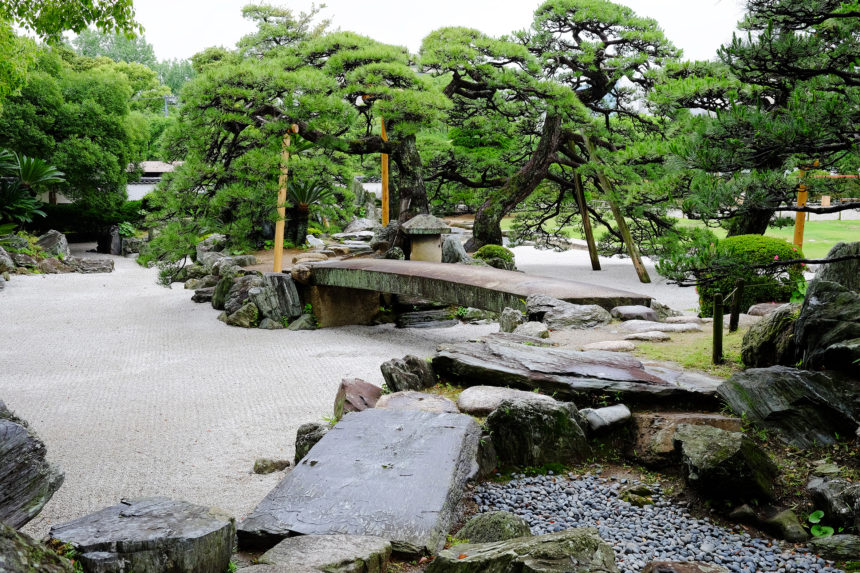 Tokushima’s rich history and culture are showcased at this museum located in Tokushima Central Park on the former castle site. Visitors can learn about the lives and influence of the prefecture’s onetime lords, the Hachisuka family. The museum also provides insight into how such features of local culture as the Awa Odori (Awa dance) and the indigo industry fit into the overall history of the Shikoku region.
Although Tokushima Castle no longer stands, the extensive Omotegoten Garden remains. It is located next to the museum and can easily be viewed in the same visit.
Hachisuka Iemasa (1558–1638) completed the castle’s construction in 1586, following his appointment as the first lord of Tokushima. It was torn down in 1875, like many other castles during the early years of the Meiji era (1868–1912), when such structures were viewed as relics of Japan’s feudal past. Today, the stone walls are all that remain.
The Tokushima Castle Museum opened in 1992 on the same site. Its design reflects the traditional style of residential architecture, as it would have looked during the Edo period (1603–1868) when it was home to the Hachisuka family. Exhibits show their cultured and multifaceted lives, with artifacts such as armor, swords, and kimono. The family also appreciated art, and the collection includes some fine examples of paintings and decorated screens.
The museum displays historic maps and diagrams, giving a detailed look at life in Tokushima when it was a thriving castle town. Life-sized models of homes and shops depict the lives of the common people. A section on naval history includes the Senzan Maru, a whaling ship for the exclusive use of the Hachisuka lord in the late Edo period. Historians believe it is the only vessel of its kind in existence. Senzan Maruis designated a National Important Cultural Property.
Outside the museum, visitors can explore the Omotegoten Garden, formerly the front garden of the castle. It features such traditional elements as a landscaped pond and a karesansuirock garden. The warlord Ueda Soko (1563–1650), who studied under the legendary tea master Sen no Rikyu (1522–1591), oversaw construction of these grounds around 1600. Today the garden is a designated Place of Scenic Beauty.
A number of bridges crisscross the garden, including one that is 10.5 meters in length and made from a single unfinished piece of green chlorite schist stone. Visitors can stroll the garden freely. Children will enjoy exploring the garden’s hidden charms and spotting the fish, turtles, and birds that make their home in and around the pond.
Tokushima’s rich history and culture are showcased at this museum located in Tokushima Central Park on the former castle site. Visitors can learn about the lives and influence of the prefecture’s onetime lords, the Hachisuka family. The museum also provides insight into how such features of local culture as the Awa Odori (Awa dance) and the indigo industry fit into the overall history of the Shikoku region.
Although Tokushima Castle no longer stands, the extensive Omotegoten Garden remains. It is located next to the museum and can easily be viewed in the same visit.
Hachisuka Iemasa (1558–1638) completed the castle’s construction in 1586, following his appointment as the first lord of Tokushima. It was torn down in 1875, like many other castles during the early years of the Meiji era (1868–1912), when such structures were viewed as relics of Japan’s feudal past. Today, the stone walls are all that remain.
The Tokushima Castle Museum opened in 1992 on the same site. Its design reflects the traditional style of residential architecture, as it would have looked during the Edo period (1603–1868) when it was home to the Hachisuka family. Exhibits show their cultured and multifaceted lives, with artifacts such as armor, swords, and kimono. The family also appreciated art, and the collection includes some fine examples of paintings and decorated screens.
The museum displays historic maps and diagrams, giving a detailed look at life in Tokushima when it was a thriving castle town. Life-sized models of homes and shops depict the lives of the common people. A section on naval history includes the Senzan Maru, a whaling ship for the exclusive use of the Hachisuka lord in the late Edo period. Historians believe it is the only vessel of its kind in existence. Senzan Maruis designated a National Important Cultural Property.
Outside the museum, visitors can explore the Omotegoten Garden, formerly the front garden of the castle. It features such traditional elements as a landscaped pond and a karesansuirock garden. The warlord Ueda Soko (1563–1650), who studied under the legendary tea master Sen no Rikyu (1522–1591), oversaw construction of these grounds around 1600. Today the garden is a designated Place of Scenic Beauty.
A number of bridges crisscross the garden, including one that is 10.5 meters in length and made from a single unfinished piece of green chlorite schist stone. Visitors can stroll the garden freely. Children will enjoy exploring the garden’s hidden charms and spotting the fish, turtles, and birds that make their home in and around the pond.
<簡体字>
德岛城博物馆和表御殿庭园
德岛城博物馆位于德岛中央公园内,着重展示德岛丰富的历史和文化。这里是德岛城的旧址,来访者可以一睹昔日藩主蜂须贺家族的生活和他们对当地的影响。如果你想了解阿波舞和蓝染工艺等德岛当地文化在整个四国地区的历史上拥有怎样的地位,在这里就能找到答案。
在被任命为德岛第一任藩主之后,蜂须贺家政(1558-1638)于1586年完成了城堡的建设。明治时代(1868-1912)早期,许多城堡都被视为封建残余而难逃被拆除的命运,德岛城也不例外。它在1875年被拆除,只剩下石头围墙残留至今,被指定为国家史迹。
1992年,德岛城博物馆在城堡旧址上建成开馆。它按照传统建筑式样设计,还原了江户时代(1603-1868)蜂须贺家族的居所。博物馆里展示的盔甲、刀剑与和服等文物,体现了当年藩主家族充满文化气息而又多姿多彩的生活。这个家族还有很高的艺术品位,收藏了众多精美的名画和装饰屏风。
馆内陈列的各时代的地图和示意图,直观展现了当时德岛城下町(以城堡为中心建立的城市)的繁荣生活,实物大小的房屋和商店模型讲述着普通人的日子。在海军历史展区,你可以看到江户时代晚期蜂须贺藩主专用的捕鲸船“千山丸”(千山号),它被指定为国家重要文化财产,历史学家们认为它是现存同类船舶中的孤品。
德岛城早已不复存在,但占地面积广阔的表御殿庭园(从前城堡的前院,又称“千秋阁庭园”)还在。这座美丽的庭园建成于1600年,由师从“茶圣”千利休(1522-1591)的武家茶人(以精通茶道闻名的战国武将)上田宗箇(1563-1650)督建。园中包含景观池塘和枯山水等诸多传统元素,各式石桥交错,更有一整块长10.5米、未经雕琢的天然青石直接横于水上,形成了一座青石桥。人们可以在此闲庭信步,孩子们则更爱探索庭园隐藏的魅力——池塘里住着鱼儿和乌龟,四周有小鸟飞翔,一派野趣盎然的景象。现已被指定为国家名胜的表御殿庭园就在博物馆旁边,可一同参观。
<繁体字>
德島城博物館和表御殿庭園
德島城博物館位於德島中央公園內,展示了德島豐富的歷史和文化,這裡是德島城的舊址,來訪者可一睹昔日藩主蜂須賀家的生活和他們對當地的影響。如果你想瞭解德島當地文化(如阿波舞和藍染產業)在整個四國地區的歷史上擁有什麼樣的地位,在這裡就能找到答案。
被任命為德島第一任藩主後,蜂須賀家政(1558-1638)於1586年完成了德島城的建設。在明治時代(1868-1912)早期,許多城都被視為封建時代產物而難逃被拆除的命運,德島城也不例外,於1875年被拆除,只剩下石頭圍牆遺留到今天,並被指定為國家史蹟。
1992年,德島城博物館在城的遺址上建成開館,按照傳統住宅設計,還原了江戶時代(1603-1868)蜂須賀家的居所。博物館裡展示的盔甲、刀劍與和服等文物,體現了當年藩主家族充滿文化氣息而又多姿多彩的生活,蜂須賀家的藝術品味也很高,收藏了很多精美的名畫和裝飾屏風。
館內陳列了各時代的地圖和示意圖,展現當時德島城下町(以城堡為中心建立的城市)的繁榮生活,實物大小的房屋和商店模型講述著普通人的日子。在海軍歷史展區,你可以看到江戶時代晚期蜂須賀藩主專用的捕鯨船「千山丸」(千山號),被指定為國家重要文化財產,歷史學家們認為千山丸是同類型船隻中唯一流傳至今的一艘。
德島城早已不復存在,但占地面積廣闊的表御殿庭園(從前城堡的前院,又稱「千秋閣庭園」)還在。這座美麗的庭園建成於1600年,由師從「茶聖」千利休(1522-1591)的武家茶人(以精通茶道聞名的戰國武將)上田宗箇(1563-1650)監督建成。園中包含景觀池塘和枯山水等諸多傳統元素,各式石橋交錯,更有一整塊長10.5公尺、未經雕琢的天然青石直接橫於水上,形成了一座青石橋。人們可以在此閒庭信步,孩子們則更愛探索庭園隱藏的魅力——池塘裡住著魚和烏龜,四周有小鳥飛翔,一派野趣盎然的景象。表御殿庭園現已被指定為國家名勝,位於博物館旁邊可一起參觀。
Mt.Bizan
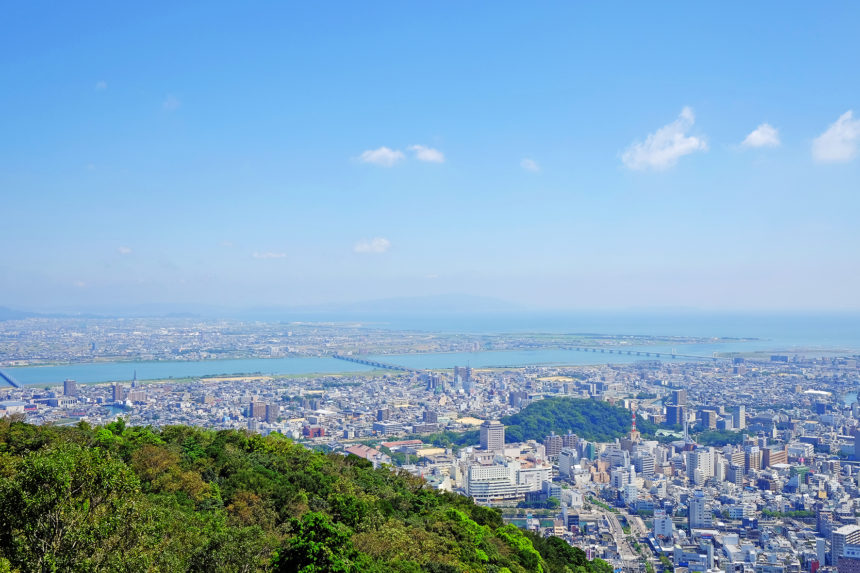
 This landmark mountain is a major symbol of Tokushima. Its name translates as “Eyebrow Mountain,” which describes its outline when seen from a distance. On a clear day, the summit commands an almost 360-degree view encompassing the Sanuki Mountains, Awaji Island, and the Kii Channel. You will also see Shikoku’s second longest river, the 194-kilometer Yoshino.
The slopes and summit are covered in cherry trees, making Mt. Bizan one of the city’s most popular spots for blossom-viewing each spring. After dark, the mountain offers a panorama touted as one of Japan’s top 100 night views. The Bizan Ropeway offers easy access to the 277-meter observatory from the fifth floor of the Awa Odori Kaikan (Awa Dance Festival Hall). The journey to the observatory takes six minutes.
This landmark mountain is a major symbol of Tokushima. Its name translates as “Eyebrow Mountain,” which describes its outline when seen from a distance. On a clear day, the summit commands an almost 360-degree view encompassing the Sanuki Mountains, Awaji Island, and the Kii Channel. You will also see Shikoku’s second longest river, the 194-kilometer Yoshino.
The slopes and summit are covered in cherry trees, making Mt. Bizan one of the city’s most popular spots for blossom-viewing each spring. After dark, the mountain offers a panorama touted as one of Japan’s top 100 night views. The Bizan Ropeway offers easy access to the 277-meter observatory from the fifth floor of the Awa Odori Kaikan (Awa Dance Festival Hall). The journey to the observatory takes six minutes.
<簡体字> 眉山 这座山峰是德岛的一个重要标志。“眉山”的名字来源于它的轮廓——无论站在哪个方向看去,山形都宛如弯曲的眉毛。天气晴朗时,眉山顶上拥有近乎360度的全景视野,赞岐山脉、淡路岛和纪伊水道尽在眼前,长达194公里的四国第二长河吉野川的全貌也一览无余。夜幕降临之后,从山顶俯瞰的全景还被选入日本夜景100强。 眉山的山坡和山顶遍布樱花树,因此也成为了每年春天德岛市最受欢迎的赏樱胜地之一。在阿波舞会馆5楼乘坐眉山索道,全程只需6分钟,就能到达277米高处的观景台。此外,千万别错过眉山最有名的点心“瀑布烧饼”,甜味清淡的豆沙包裹在印着菊花纹样的烧饼里,香气十足,满是怀旧的味道,很适合登高望远时品尝。
<繁体字> 眉山 這座標誌性山峰是德島最主要的象徵,「眉山」的名字源於外形——無論站在哪個方向看去,山形都宛如同彎曲的眉毛。天氣晴朗時,眉山頂上擁有幾乎360度的全景視野,讚岐山脈、淡路島和紀伊水道盡在眼前,長達194公里的四國第二長河吉野川的全貌也一覽無餘。夜幕降臨後,從山頂俯瞰的全景還被選入日本百大夜景。 眉山的山坡和山頂遍佈櫻花樹,成為每年春天德島市最受歡迎的賞櫻勝地之一,在阿波舞會館5樓乘坐眉山纜車,全程只需6分鐘,就能到達海拔277公尺的觀景台。此外,別錯過眉山最有名的點心「瀧之烤麻糬」,甜味清淡的豆沙包裹在印著菊花紋樣的烤麻糬裡,香氣十足,滿是懷舊的味道,很適合登高望遠時品嘗。
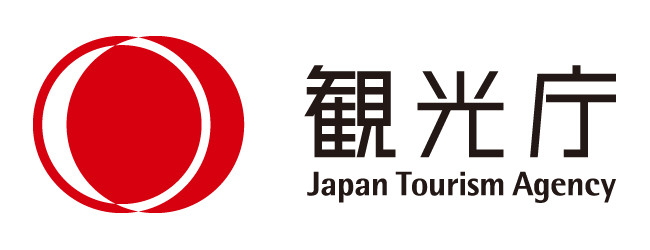 This English-language text was created by the Japan Tourism Agency.
This English-language text was created by the Japan Tourism Agency. 




